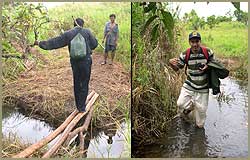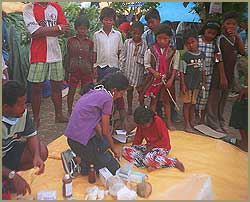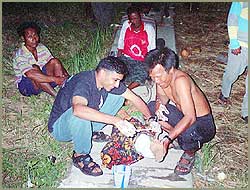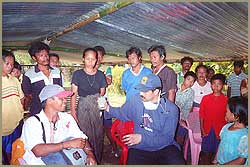|
St.
Johnís Disaster Relief Team in the Nicobars
Work begins
 |
 |
Trecking
to and between camps on
Teressa island |
The
estimated toll on Nancowry block of islands has been estimated
at around 5500 missing or dead out of a total of over 12633
(2001 census) See Figure A. The lack of publicity and media
coverage compared with Car Nicobar and poor accessibility
are possible reasons for a slight delay in intervention. Our
teams were based at three locations but served many other
islands using all available transportation means, even trekking
through the tropical jungles with backpacks of medicine, wading
and swimming between island and ships anchored off destroyed
jetties. Teams were based on Kamorta Island, Teresa Island,
Car Nicobar and Port Blair. From these islands, teams would
mobilize everyday to serve the basti populations on Katchal
especially the dense jungles on Upper Katchal near Vyatapu,
Daring, the Pilpilou-Kakana village camps, the jungles inland
on Car Nicobar, the camps of Chowra Island's evacuated population
on Teressa Island, bastis formed between the destroyed Bengali-Alorang
villages and the bastis/camps of populations from destroyed
Kapanga-Mildera villages on Teressa. Strikingly, the islands
have a over 81% literacy rate and with the board examinations
due in March 2005, most Education Officers were well aware
of the need for additional classes at the earliest and also
a postponement. Education has been badly damaged as most schools
were in the coastal villages and on Katchal alone at last
count over 70-80 teachers out of 130 were missing or dead.
Till medical assistance arrived there were numerous heroes
like the nurse Sr. Dora and the volunteer Shanmugan on Katchal
Island who ran a clinic from a church premises treating the
wounded till Dr. Naresh Lal arrived on Wednesday.
 |
 |
| Pillpillou
- Kakana villages on Kamorta |
Kamorta
was the Nancowry division's headquarters and had electricity
restored with adequate water stored with most of its 2915
(2001 census) alive except for one person who decided to try
and salvage his stored money for his wedding between tsunami
waves lashing the fishing village near the coast. Islands
on all sides that protected it from damage surround Kamorta.
The island of Trinket is apparently torn into three and most
mortality is on Katchal Island (>3500 out of 5000 plus
population). The islands of Chowra (500 missing/dead/1385-2000
population); Teressa (300/2026-2200); Bambooka (4/40-55);
Katchal (3500/5312-7000); Trinket (?/300); Nancowry (300/927-1000);
Car Nicobar (18000/25000) were other estimates. The jetty
now gets water up to 1.6 meters slowing down loading during
that period of time. The jetty is the main point for operations
- relief, medical, and water, fuel and shelter distribution.
The three vessels MV Ramakrishna, MV Bulbul and MV Long Island
and their hard working captains and crew were to be our best
friends throughout our work in the area. Later, MV Shompen
and Capt Pillai carried us on our small missions. Capt Pillai
actually risked his life getting us onto the Teressa Island
in a rather dangerous outboard boat and once again by jumping
into the water to assist us while we swam to his vessel anchored
out at sea in an attempt to communicate and decide on plans
for the team. The team on Teressa Island found that the tents
and sleeping bags pitched on the helipad near the basti most
comfortable for a starry night sleep to enable them to wake
at dawn (5 am) and put in a full days work. Of course, our
friend Bandana Aul ("Bat-girl" to us!) kept us going
with her stories of the tribal division of Nancowry. Bandana
is the daughter of a retired General in Chandigarh and is
a frequent visitor to these islands during her quest at research
on various aspects of bats unique to these islands. Her rapport
and local knowledge with the island population assisted us
in carrying out our duties. It was the naval landing craft
L-34 with Lt Cdr Bellary in command that thankfully dropped
our team to the island of Teressa after the previously failed
attempt aboard MV Long Island.
Teams
would base themselves in bastis or camps and some of us would
trek through the islands till evening helping persons in need
of medical assistance. When teams found seriously injured
or ill patients we would innovate and with the assistance
of the village tribals evacuate them to hospitals wherever
possible. Dr. Naresh Lal was the Chief Medical Officer at
the Community Health Center on Kamorta whom we shared our
stored supplies and assisted. He was the first one on Katchal
Island on Wednesday and was actually stranded for two -three
days and reported back the sad state of affairs. His manpower
on all islands mostly stuck to their posts in spite of many
a PHC being washed away and destroyed. Dr. Michael (PHC Medical
Officer, Teressa Island) was one we worked alongside with.
What we first saw was this young doctor short pants and vest,
stethoscope hanging around his neck and a knee hammer in his
pant loops. The team worked hard with Michael in their treks
from basti to basti covering all in need of medical assistance.
Dr. Felicetta (PHC Medical Officer) holding fort during the
few days Dr. Lal was on Katchal helped us take care of the
two patients we disembarked from Rajput while at sea. Both
men in their early 20s had lost families in the tsunami and
had received initiation of treatment on board I.N.S. Rajput
under the care of Surg Lt Cdr Rath.
 |
 |
| Fractures
on bangala |
One had a possible traumatic fracture dislocation elbow joint
with a large hematoma and possible secondary infection. The
other had a pneumonia and acute severe asthma. The team on
their Upper Katchal visit had to do an Incision and Drainage
and injected antibiotics for a patient in severe pain due
to cellulites and large abscess formation on a foot of a person
who refused to be evacuated. The team also identified two
other patients evacuated onto Teressa Island with severe traumatic
spinal paraplegia and was able to support and minimize damage
before getting them evacuated to Car Nicobar. On Car Nicobar,
a young boy child found inland on Car Nicobar needed a reduction
of a hip joint, rather painful but needed to enable transportation
to the nearest hospital.
In most medical clinics in the field, we noticed no epidemics
(sea washing away most debris/carcasses; water sources inland
and protected from the death and destruction) and most who
were brought in were children (44.7-60.7%). Among morbidity
patterns as expected were injuries 10-24% (few major as illustrated
above but mostly minor soft tissue injuries); Respiratory
problems 28-76.2% (upper and lower respiratory problems, hyperactive
airways, occasional pneumonia - mainly due to exposure to
natural elements in the present inadequacies of clothing and
shelter); Skin problems 8-24.7% (an exaggeration of usual
problems, predominately children, on exposed parts of the
body, with no burrows/family histories, probably related to
the slush and the presence of tall grass to be walked through
to reach new basti sites). At present there is no need for
any supplies beyond the Essential Drug List made out by WHO
and neither should nay other drugs be allowed into the area.
Every evening teams would sit around their tents or at the
dispensary set up (usually the only meal of the day!) and
discuss the days events completing report and plan for the
day. Morale was kept high and team responsibilities included
Team doctors (to monitor team health, Doxy for malaria prophylaxis),
Team Logistic officer (check and monitor supplies), Team Mascot
(to bear the brunt of our jokes and jabs) and even Team entertainer
(which invariably changed persons depending who felt the happiest!).
Routine medical needs continue and even interventions for
delivery and labour are usually not catered for in disaster
relief. Our team on Teressa had to assist in such routine
care and support. At other clinics, patients on AntiTB drugs,
Diabetics, Hypertensives and even persons with poor eyesight
needed their routine care. When these patients came to our
notice we did inform in writing their contact details to enable
restoration of their routine care.
 |
 |
| Khalasi
camp teaching chlorination o fwater supplies |
Apart
from curative medicine and surgical interventions, Teams stressed
on and taught through demonstrations-practice methods to chlorinate
stored drinking water sources, encouraged trench latrines
and personal hygiene. This regular medical status feedback
was sent daily to the local administrator and the navy to
enable needs assessment and thus the urgent requests for additional
tents and tarpaulins to protect against the elements. The
populations deep in the jungles of Upper Katchal were relatively
well protected from the elements and therefore showed less
respiratory problems. Those on the 110 mt elevation on northern
Kamorta (Pilpilou and Kakana) with little tree cover certainly
had to live exposed to wind and even rainfall which occurred
on more than once. Teams initially on Car Nicobar assisted
the lone 4 nurses in the performance of their duties and then
began field trips into inland Car Nicobar to help people in
need. On their return to Port Blair, they were engaged in
specifically two refugee camps (Nirmala School - 2000 people;
Haddo Public School - 800 people) running clinics including
antenatal and postnatal care. They also assisted in all activities
of camp life as a part of psychological support - involving
victims in tasks needed in camp life, sitting, talking, counseling,
pre and school related classes (Action songs, Mathematics,
Science, Language), even meditation and play/diversion therapy
with the children in the camps. Other camps covered partially
were Chouldari (300), Chidia Tapu (250), New Wandoor (116)
and Wandoor (75). As the camps began to close over the weekend
it was decided that they could be withdrawn - a job well done
in an hour of need! 
Tsunami
Home
Mr.
Ajit Chaudhuri, Executive Director & Ms.Skalzang Youdon, Programme
Officer
ajitc@intoday.com
Care
Today Fund, F14/15 Connaught Place, New Delhi 110 001, India
Telephone: 011 2331214 (direct) 011 23315801/2/3/4 Extn.287
|
|

